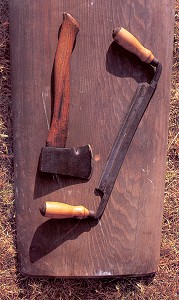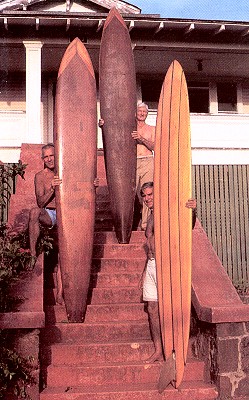 |
surfresearch.com.au
obelian
: early big wave design history, 1989
|
|
Surfer,
Volume 30 Number 10, 1989,
pages 104-105.
Give
It
the AxeEarly Development of the Modern Gun by George Orbelian Board,
Axe and Knife
Photograph : Gary Lynch, page 104. |
 |
During the
Summer
of 1936 Wally Froiseth, Fran Heath and John Kelly spent a frustrating
morning "sliding ass" (sliding tail/sideslipping) on their
square-tail
planks, in perfect 15-18' rights at Brown's surf near
Diamond Head.
They went home for lunch where, in frustration, Kelly grabbed an axe and took a calculated, slashing cut at the tail-rail of his board.
They shaped and blended the new, narrow vee-tail, and were back out at Brown's by 2:00 the same afternoon - the varnish still sticky.
Kelly caught his first wave, felt the narrow vee-tail bite, and shot across a wall just under the lip.
The narrow-tail gun was born, and named the Hot Curl.
They went home for lunch where, in frustration, Kelly grabbed an axe and took a calculated, slashing cut at the tail-rail of his board.
They shaped and blended the new, narrow vee-tail, and were back out at Brown's by 2:00 the same afternoon - the varnish still sticky.
Kelly caught his first wave, felt the narrow vee-tail bite, and shot across a wall just under the lip.
The narrow-tail gun was born, and named the Hot Curl.


